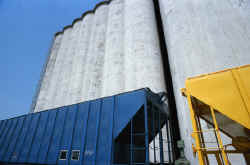Anatomy of a Jam

Food grains, coal, and pharmaceutical powders are commonly stored in silos from which they can be retrieved through funnel-shaped receptacles called hoppers. These openings periodically plug up, but there’s no detailed theory explaining how hoppers jam. In the 1 January PRL, a team from Taiwan provides the first mathematical explanation of the phenomenon by running real experiments and computer simulations on the two-dimensional equivalent problem: disks falling through a slot.
One common solution to the jamming problem for industrial hoppers is the sledge hammer. Many factory hoppers bear dents, “telling the tale of this time honored solution,” says Troy Shinbrot of Rutgers University in Piscataway, NJ. For a more scientific approach, Kiwing To of the Academia Sinica in Taipei, Taiwan, and his colleagues, placed 200 5-mm-diameter stainless steel disks on a flat, horizontal hopper surface. When the researchers tilted it to the vertical, the disks fell toward a V-shaped funnel with an opening in the middle. They controlled the shape of the funnel and the width of its opening and trained a video camera on the descending disks. In trials where the disks became jammed, the flow was blocked by the formation of an “arch”–a string of adjacent disks that became lodged just above the opening.
No jams occurred when the opening was five times larger than the disk diameter, but jams invariably occurred when the opening was twice the disk diameter. The probability was the same when the V-shaped wall angles were between 34 and 60 degrees, but it changed dramatically for steeper angles–a subject that To’s group is now investigating.
To and his colleagues repeated the experiments in computer simulations based on a “random walker” model, which assumes random trajectories for disks flowing toward the hopper opening. To compute the jamming probability for a given opening size, the researchers counted up the possible ways of building a stable arch and compared that to the total number of paths by which the disks could descend. The simulated jamming probabilities closely matched the laboratory tests.
Previous experiments and computer simulations suggested that jamming is caused by arches that form near the hopper opening. “But no one knew how to discuss arch formation in a quantitative way,” says To. This research provides a new tool for understanding the transition between flowing and jamming states, adds Shinbrot. The approach taken by To’s group, which relies on statistical physics techniques, has rarely been applied to granular research, Shinbrot says. “It is a welcome addition to the field.”
One potential spinoff of this study would be to improve the design of hoppers for processing granular materials, says To. The analysis may also shed light on other two-dimensional systems such as traffic jams, can and bottle transport systems in factories, and baggage flow on conveyor belts. Shinbrot agrees that practical applications of this work may be broad but believes the paper’s main contribution is to explain the phenomenon of jamming in a scientifically elegant way.
–Steve Nadis
Steve Nadis is a freelance science writer based in Cambridge, MA.


